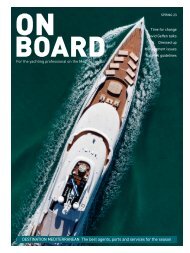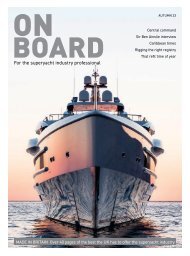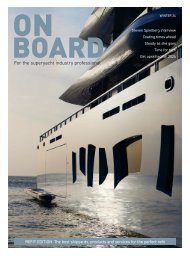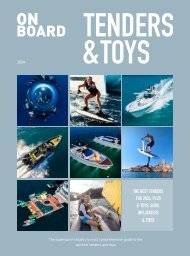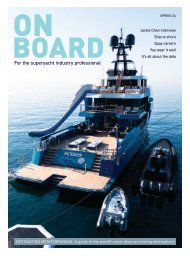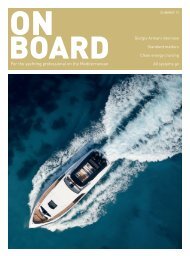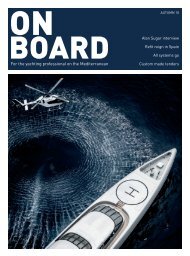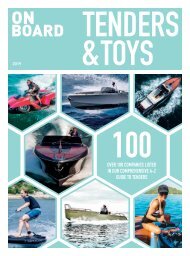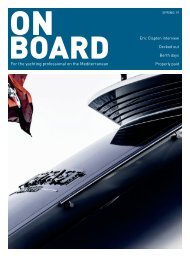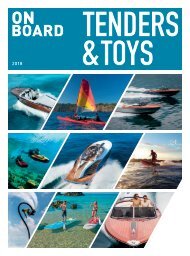ONBOARD Magazine winter 2019
You also want an ePaper? Increase the reach of your titles
YUMPU automatically turns print PDFs into web optimized ePapers that Google loves.
ADVERTORIAL<br />
READING YOU<br />
LOUD AND CLEAR<br />
With the change in SOLAS regulations<br />
covering communications in the event<br />
of an emergency or fire, clear and reliable<br />
radio contact is essential<br />
In one incident in 2016, fire on two multi-million pound yachts<br />
in Abu Dhabi Marina Yacht Club spread, eventually destroying<br />
six further vessels. Fire risk on yachts is very real.<br />
As you’ll know the Safety of Life at Sea (SOLAS) regulations set<br />
down minimum standards for protecting against risks, including<br />
fire. In late 2016, the SOLAS regulations concerning fire radios<br />
changed. This makes it important to review your equipment and<br />
procedures to ensure you are still in compliance.<br />
The change to the SOLAS regulations<br />
The new rule states that ships built from 1 July 2014 must have<br />
a minimum of two portable two-way radiotelephone apparatus<br />
for fire-fighter communication for every fire party. They must<br />
be explosion proof or intrinsically safe. Older ships must comply<br />
by their first survey after 1 July 2018. Therefore, now is very<br />
much the time to act on this if you have not done so already.<br />
What happens when there is a fire?<br />
With the regulatory spotlight shining brightly on fire radios, the<br />
developers at Channel28 undertook some primary research into<br />
what the optimum fire radio would look like. We<br />
spent time with crews in potential fire situations<br />
and discovered or confirmed the following:<br />
• Radios on their own cannot be heard with a<br />
mask and helmet on<br />
• The crews need to get ready quickly, so ease<br />
of fitting is important<br />
• It gets hot inside a fire suit and the crew<br />
members sweat – especially fighting a fire<br />
• Dealing with a fire onboard a ship is a stressful<br />
situation!<br />
Looking at the existing market, there were<br />
a number of microphone solutions such as<br />
bone conduction and throat mics with inhelmet<br />
speakers. But these need to be<br />
in exactly the right position to work well.<br />
Watching the crews get ready during our<br />
research, we observed that these are hard<br />
to position, and they rarely stay in place<br />
for long when firefighting.<br />
We also worked with the crews to understand<br />
how the radio comms operate. It became<br />
clear that the fire teams need to focus on<br />
the job in hand and not the general comms<br />
around the yacht.<br />
Overcoming these fire radio challenges<br />
Armed with this information, our technicians went about devising<br />
the optimum radio equipment for firefighting which complied<br />
with the new regulations.<br />
The research led us to incorporating the audio within the breathing<br />
apparatus mask. We now supply Draeger or Scott in-mask comms.<br />
Normally this requires an upgrade to the mask or a new mask<br />
with the comms fitted. But the advantage of this is that once<br />
the mask is fitted, the earpiece and microphone are ready to use.<br />
Typically, the breathing apparatus mask is stored with the<br />
breathing apparatus kit, and the radio sits on charge. So with<br />
our new solution, deployment is as simple as:<br />
• Clipping the radio on the belt<br />
• Clipping the large push-to-talk button on the front of the<br />
clothing. This is easy to press with gloved hands or the back<br />
of the fire hose<br />
• Plugging the mask cable to the large push-to-talk button<br />
And what about the issue of the fire teams being distracted by<br />
the general comms of the ship? We advise setting up the onscene<br />
commander with two radios – one to communicate with<br />
the bridge and crew, and the other to speak with the fire team.<br />
Then you are ready to go!<br />
ABOUT CHANNEL 28<br />
Channel 28 was formed in 2012 by two experienced<br />
engineers to develop well-engineered products for the<br />
marine sector, in particular, superyachts. Blending physical<br />
and digital innovation, we are experts in communications<br />
technology. Our flagship product cComm is a platform<br />
that provides secure crew communications, alarm and<br />
monitoring interfaces, and tender and jet ski tracking.<br />
For more information about fire radios and our other<br />
products, or to discuss an engineering project you would<br />
like to commission, call +44 (0)1306 257 250<br />
or email info@channel28.co.uk today<br />
<strong>ONBOARD</strong> | WINTER <strong>2019</strong> | 51



